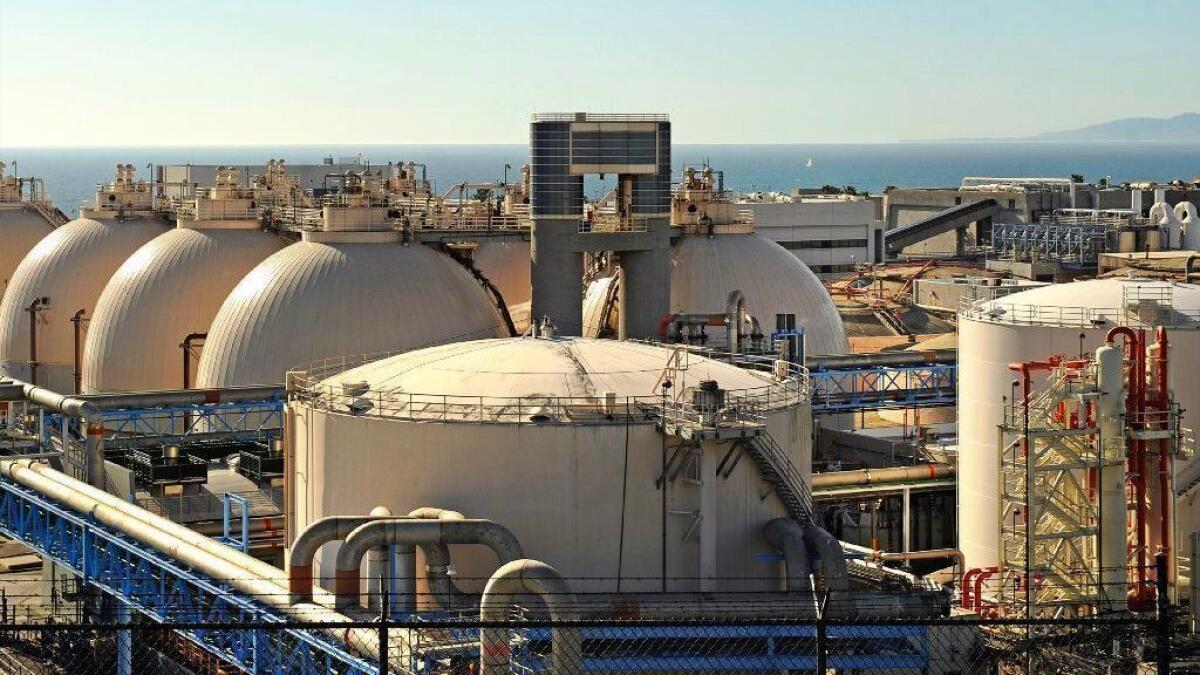L.A.’s ambitious goal: Recycle all of the city’s sewage into drinkable water

- Share via
Los Angeles has a new water project in mind that could cost $8 billion, take 16 years to complete and provide as much as one-third of the city’s supply.
Local officials aren’t talking about building a new dam or lining the coast with desalination plants or towing icebergs from the Arctic.
They are eyeing the river of treated sewage that pours into the Pacific Ocean, day in and day out, from L.A.’s wastewater plants.
In a dramatic shift for a city notorious for looking afar for most of its water, Mayor Eric Garcetti vowed this week that the city will be recycling all of its wastewater by 2035 and using it to reduce its need for imported supplies.
“It is really a game-changer,” said Richard Harasick, senior assistant general manager at the L.A. Department of Water and Power.
Currently, recycling provides only 2% of the city’s water.
The Garcetti administration says that figure can jump to 35% if L.A. stops dumping its treated effluent into the sea and instead uses it to replenish the local groundwater reserves that help supply municipal customers.
Doing that will require costly equipment upgrades at the Hyperion Water Reclamation Plant, new groundwater wells, construction of a 15-mile pipeline, and as much as $8 billion financed by DWP to pay for it all.
The plan will also require a change of heart by L.A. residents, who 18 years ago succeeded in killing a city project that would have used treated sewage to recharge the San Fernando Valley aquifer.
City officials are optimistic. They say years of drought, declining imports and the high profile of a similar program in Orange County have softened resistance.
“People are accepting it now,” Harasick said. “We don’t see that as an issue going forward.”
For a decade, Orange County water agencies have used purified wastewater to recharge a regional aquifer used for drinking supplies. Sanitation districts in southeast L.A. County have been doing the same thing since 1962.
What role should the L.A. River play in a future Los Angeles? »
The key to L.A.’s water recycling ambitions is the Hyperion plant near Dockweiler State Beach. It processes 81% of the city’s sewage and discharges an average of 190 million gallons a day into a five-mile outfall pipe in Santa Monica Bay.
The city wants to upgrade Hyperion with advanced treatment technology, pipe the purified water inland and inject it into the aquifers that underlie much of the L.A. Basin.
Plenty of underground storage space is available thanks to recent legal judgments that freed up capacity in local groundwater basins.
“We have the technology, we have the background on what we need to do,” said Traci Minamide, chief operating officer of the L.A. Bureau of Sanitation. “We feel we’re there.”
One thing they don’t have is the funding.
“Money’s going to be the big thing,” said Mark Gold, UCLA’s associate vice chancellor for environment and sustainability.
“It’s a bold move by the city,” he added. “But if you look at water planning going back to the early [aughts], there’s been talk about this. This is not a new concept.”
Harasick said he was confident the city can fund the program through bonds, grants and low-interest government loans.
He also predicted that by 2035, recycled supplies — which are now significantly more expensive than imported water — would cost roughly the same as imports.
Currently, it is against state policy to put recycled water directly into municipal systems. It must first spend some time in aquifers or reservoirs and mix with other sources.
But the state is considering new standards that would allow agencies to skip that step.
If that happens, Harasick said DWP would use some of the scrubbed wastewater for groundwater recharge and would send some directly into the city’s distribution system.
As L.A. strives to capture more of the torrents of urban runoff that drain to the ocean during winter storms, it could also divert stormwater into the sewer system, treat it and add it to groundwater reserves.
Southern California cities are in the vanguard of diversifying their water sources, said Josué Medellín-Azuara, acting associate professor of environmental engineering at UC Merced.
L.A.’s recycling goal is very ambitious, he added, “but I think it is achievable.”
Twitter: @boxall
More to Read
Sign up for Essential California
The most important California stories and recommendations in your inbox every morning.
You may occasionally receive promotional content from the Los Angeles Times.














